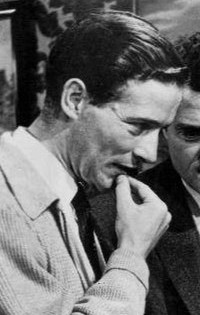
Michael Joseph Anderson was an English film and television director. His career spanned nearly 50 years across three countries, working at various times in the United Kingdom, the United States, and Canada. His most critically and commercially successful works include the World War II film The Dam Busters (1955), the dystopian sci-fi film Logan's Run (1976), and the comedy adventure epic Around the World in 80 Days (1956), which won the 1957 Academy Award for Best Picture.
Frank Launder was a British writer, film director and producer, who made more than 40 films, many of them in collaboration with Sidney Gilliat.

Grandma's Reading Glass is a 1900 British short silent drama film, directed by George Albert Smith, featuring a young Willy who borrows a huge magnifying glass to focus on various objects, which was shot to demonstrate the new technique of close-up. The film, according to Michael Brooke of BFI Screenonline, "was one of the first films to cut between medium shot and point-of-view close-up. It was destroyed in a fire at Warwick Trading Company's studio facility in 1912.

As Seen Through a Telescope is a 1900 British short silent comedy film, directed by George Albert Smith, featuring an elderly gentleman getting a glimpse of a woman's ankle through a telescope. The three-shot comedy, according to Michael Brooke of BFI Screenonline, "uses a similar technique to that which G.A. Smith pioneered in Grandma's Reading Glass (1900)," and although, "the editing is unsophisticated, the film does at least show a very early example of how to make use of point-of-view close-ups in the context of a coherent narrative ." "Smith's experiments with editing," Brooke concludes, "were ahead of most contemporary film-makers, and in retrospect it can clearly be seen that he was laying the foundations of film grammar as we now understand it."

The Kiss in the Tunnel, also known as A Kiss in the Tunnel, is a 1899 film British short silent comedy film, produced and directed by George Albert Smith, showing a couple sharing a brief kiss as their train passes through a tunnel, which is said to mark the beginnings of narrative editing. The film is the first to feature Laura Bayley, Smith's wife.

Fire! is a 1901 British short silent drama film, directed by James Williamson, showing the occupants of a house in Hove being rescued by the local fire service.
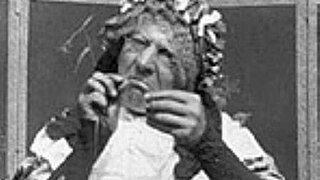
Grandma Threading her Needle is a 1900 British short silent comedy film, directed by George Albert Smith, featuring a grandma trying to get a thread though a needle. The sole purpose of the single-shot film, like the director's earlier Old Man Drinking a Glass of Beer (1898), according to Michael Brooke of BFI Screenonline, "is to record changing facial expressions for the purposes of entertainment."
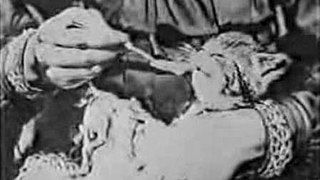
The Sick Kitten is a 1903 British short silent comedy film, directed by George Albert Smith, featuring two young children tending to a sick kitten.
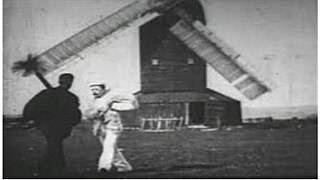
The Miller and the Sweep is a 1898 British short black-and-white silent comedy film, directed by George Albert Smith, featuring a miller carrying a bag of flour fighting with a chimney sweep carrying a bag of soot in front of a windmill, before a crowd comes and chases them away. The film, according to Michael Brooke of BFI Screenonline, "was one of the first films made by G.A. Smith, shortly after he first acquired a camera," and is also, "one of the earliest films to show a clear awareness of its visual impact when projected."

The Old Maid's Valentine is a 1900 British short silent comedy film, directed by George Albert Smith, which features the titular Miss Pimple receiving an unpleasant surprise on 14 February. The film, according to Michael Brooke of BFI Screenonline, "is essentially a facial - a medium close-up shot of a single performer whose changing expression constitutes virtually all the film's dramatic action." David Fisher points out that, "the flapping of the sheet of paper and the movement of the calendar betray the open-air set," which, "makes it difficult to read the message: Just like Mama," whilst, "the remarkably well-behaved cat," which, "sits patently licking its paws," "suggests that Smith may have already learned the trick of smearing the cat's fur with food."

The X-Rays is an 1897 British short silent comedy film, directed by George Albert Smith, featuring a courting couple exposed to X-rays. The trick film, according to Michael Brooke of BFI Screenonline, "contains one of the first British examples of special effects created by means of jump cuts" Smith employs the jump-cut twice; first to transform his courting couple via "X rays," dramatized by means of the actors donning black bodysuits decorated with skeletons and with the woman holding only the metal support work of her umbrella, and then to return them and the umbrella to normal. The couple in question were played by Smith's wife Laura Bayley and Tom Green.
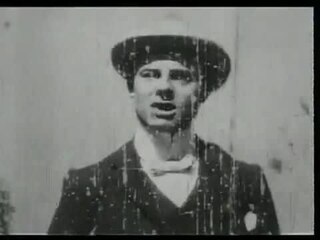
The Big Swallow is a 1901 British short silent comedy film, directed by James Williamson, featuring a man, irritated by the presence of a photographer, who solves his dilemma by swallowing him and his camera whole. The three-shot trick film is, according to Michael Brooke of BFI Screenonline, "one of the most important early British films in that it was one of the first to deliberately exploit the contrast between the eye of the camera and of the audience watching the final film".

Flying the Foam and Some Fancy Diving is a 1906 British short silent comedy film, directed by James Williamson, featuring a man diving from Brighton Pier while mounted on a bicycle, in both forward and reverse motion. This trick film, according to Michael Brooke of BFI Screenonline, "adds additional layers of entertainment, firstly by showing the stunt from multiple angles and then by showing it in reverse motion so that Reddish appears to be performing the impossible feat of riding his bicycle vertically out of the sea". It is believed to be an extended version of Professor Reddish Performing his Celebrated Bicycle Dive from Brighton West Pier (1902), supplemented by more conventional footage of pier divers at a later date.

The Little Match Seller is a 1902 British short silent drama film, directed by James Williamson, retelling the classic 1845 Hans Christian Andersen fable of the sad life and tragic death of a little match seller. This major fiction film of the period was, according to Michael Brooke of BFI Screenonline, "a serious attempt at depicting a person's inner emotional life on film through purely visual means, using trick effects not to provoke laughter but for serious dramatic reasons."

Attack on a China Mission is a 1900 British short silent drama film, directed by James Williamson, showing some sailors coming to the rescue of the wife of a missionary killed by Boxers. The four-shot film, according to Michael Brooke of BFI Screenonline, was innovative in content and technique. It incorporated a reverse-angle cut and at least two dozen performers, whereas most dramatic films of the era consisted of single-figure casts and very few shots. Film historian John Barnes claims Attack on a China Mission had "the most fully developed narrative" of any English film up to that time."

Stop Thief! is a 1901 British short silent drama film, directed by James Williamson, showing a tramp getting his comeuppance after stealing some meat from a butcher and his dogs. "One of the first true 'chase' films made not just in Britain but anywhere else", according to Michael Brooke of BFI Screenonline. It was released along with Fire! (1901), "indicating the direction Williamson would take over the next few years, as he refined this new film grammar to tell stories of unprecedented narrative and emotional sophistication."
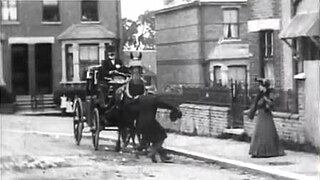
An Extraordinary Cab Accident is a 1903 British short silent comedy film, directed by Walter R. Booth, featuring a gentleman making a miraculous recovery after being trampled underfoot by a horse and cab. The film, "seems something of a step back," "compared with the elaborate special effects fantasies that director W.R. Booth and producer R.W. Paul had already concocted," but according to Michael Brooke of BFI Screenonline, "more complex special effects might well have worked against the impression Booth and Paul were clearly seeking to create, which is that of a man being genuinely run over by a horse-drawn cab, his body being knocked down and trampled by the horse's hooves."
The Unfortunate Policeman is a 1905 British short silent comedy film, produced by Robert W. Paul, featuring a policeman chasing a young painter after he tips a pot of paint over him. The film is an, "elaborate chase comedy," which according to Michael Brooke of BFI Screenonline, "is an example of the increasing use of real locations in R.W. Paul's work." Film historian Ian Christie adds, "the irreverent and disrespectful treatment of the policeman would soon become impossible in British films, thanks to the notorious list of proscriptions laid down by the British Board of Film Censors shortly after its creation in 1912."

Willie's Magic Wand is a 1907 British short silent comedy film, directed by Walter R. Booth, featuring a young boy terrorising the household with his father's magic wand. Similar to "earlier trick films The Haunted Curiosity Shop and Undressing Extraordinary ", this is, according to Michael Brooke of BFI Screenonline, "essentially a series of [loosely linked] special-effects set pieces", but "the print in the National Film and Television Archive is incomplete, omitting amongst other things a come-uppance where Willie is punished for his misdemeanours by being turned into a girl, thus depriving him of more than one magic wand". A clip from the film is featured in Paul Merton's interactive guide to early British silent comedy How They Laughed on the BFI website.
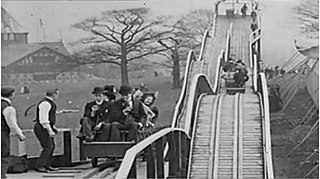
A Switchback Railway is an 1898 British short black-and-white silent actuality film, directed by Robert W. Paul, featuring patrons riding on a switchback railway at a fairground at Alexandra Palace, where Blandford Hall can be seen in the background. "This dynamically composed actuality," according to Micahael Brooke of BFI Screenonline, "was clearly a success, so much so that James Williamson and the Riley Brothers released their own switchback railway films only a few months later." It is included on the BFI DVD R.W. Paul: The Collected Films 1895-1908. It is arguable that the filmmaker, R.W. Paul, missed a trick by not placing the camera inside one of the moving cars to simulate the ride from the passenger's perspective, although he might have had difficulty keeping the camera steady. Nonetheless, the film was clearly a success, so much so that James Williamson and the Riley Brothers released their own switchback railway films only a few months later.

















